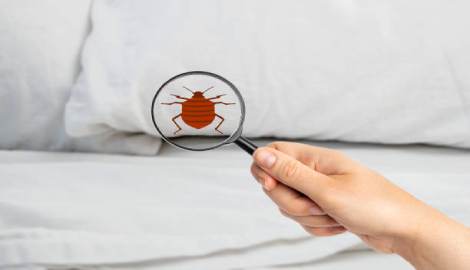A bed bug infestation can be difficult to treat. Using steam, Cryonite, and chemical treatments requires close attention to detail and routine, frequent inspections.
Look for fecal stains, blackish spotting on the skin, and tiny eggs in the cracks of furniture. Also, place encasement bags over mattresses and box springs.
Inspection

Because of their tiny size, bed bugs can be difficult to detect with the naked eye. Look for dark red fecal spots, shed skins (which appear as light-colored specks), and eggs or egg shells. You can also smell them – they give off a sweet, musty odor from their pheromones.
Strip the bed and examine the seams, tufts and tags on both the mattress and box spring. Inspect other furniture near your bed, including nightstands and dressers, and the cracks of the headboard.
In addition to a visual inspection, a professional from Western Exterminator can use a trained canine to sniff out live and dead bed bugs, as well as viable eggs. Dogs are highly trained to be able to pick up odors that would be missed with a human nose. If an infestation is discovered, the expert can recommend the best course of treatment.
Treatment
Bed bugs can be tricky to remove from a home, even when professional help is sought. Many people try to solve the problem themselves with store-bought chemicals, but these are often ineffective and can lead to a return of the pests.
The first step in treatment is to vacuum every surface of the room, including baseboards and furniture, as well as mattress seams and crevices. The vacuum cleaner may need to be pumped several times. Then, the exterminator may spray the bedroom with insecticide. He will also place pesticide strips in any nooks or crevices that the bugs are likely to hide, such as under loose screw heads in headboards or bed frames and behind wall hangings.
Any items that can’t be treated should be bagged in large storage bins and duct taped shut. Then, the bins should be placed in a kill chamber, such as one that is made out of a large plastic storage container, for a few days or however long the manufacturer recommends.
Prevention

Because bed bugs are so adept at hiding, you and your professionnel desinsectisation punaise de lit will likely have to look hard to find them. They are most likely to be seen in the open spaces around headboards and bed frames, within mattress or box spring seams, behind baseboards, and in the cracks of door or window frames. They may also be found in upholstered furniture, such as sofa cushions. In some cases, you might be able to see them, but only with a magnifying glass. Other clues include red, bumpy and itchy bite marks on your skin, dark red to black stains on bedding or pillows, and light-colored shed bed bug shells and eggs.
You can help prevent a bed bug infestation by thoroughly cleaning your home and removing clutter. Washing all clothing, bedding, and other fabric items that can withstand hot water (above 120 degrees Fahrenheit) or in a dryer for 30 minutes will kill any bugs and eggs.
Follow-Up
Once your home has been treated for bed bugs, it can be difficult to tell if treatment was successful. A good way to test for success is to inspect and monitor your space and the surrounding living areas for bed bug signs and bites.
If you still see signs of infestation, continue to follow these steps until you can confidently say that the pests are gone. Remember that large infestations are harder to treat and may require multiple treatments.
Conclusion:
It is important to store clothes, linens, toys, and other items in plastic bags or containers to prevent them from becoming re-infested. If possible, treat infested materials before storing them. This can be done by hot laundering, steaming, or freezing (freezing treatments do not rely on chemicals). You can also use diatomaceous earth (DE) to create a barrier around your home. DE is a natural, powder-like substance that is safe for humans and pets when used properly.





